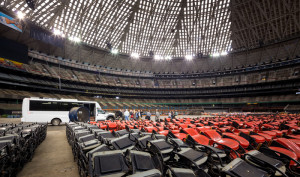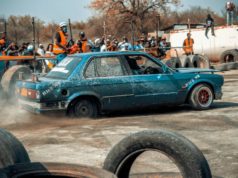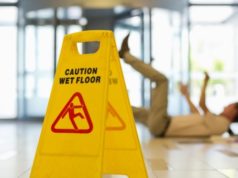 WASHINGTON, DC – March 23, 2015 – (RealEstateRama) — Houston’s iconic NRG Astrodome “can and should live on” as a multi-use park that will enhance the quality of life for residents of the city, serve as a popular tourist destination, and catalyze economic development that enhances the greater NRG Park and benefits the region as a whole, according to a report released today from the Urban Land Institute (ULI).
WASHINGTON, DC – March 23, 2015 – (RealEstateRama) — Houston’s iconic NRG Astrodome “can and should live on” as a multi-use park that will enhance the quality of life for residents of the city, serve as a popular tourist destination, and catalyze economic development that enhances the greater NRG Park and benefits the region as a whole, according to a report released today from the Urban Land Institute (ULI).
The Astrodome, Harris County Texas: A Vision for a Repurposed Icon, is a comprehensive follow-up to recommendations made last December by a panel of nationally renowned land use and urban planning experts convened by ULI to evaluate reuse possibilities for the vacant sports facility, which is part of the 350-acre NRG Park that also includes NRG Stadium, NRG Center, and NRG Arena. The panel’s visit, which took place December 14-19, was requested by the Harris County Sports and Convention Corporation (HCSCC). Preliminary recommendations were made by panelists at the conclusion of that week.
The panel was chaired by longtime ULI member Wayne Ratkovich, president of The Ratkovich Company, a Los Angeles-based firm that specializes in urban infill and rehabilitation projects primarily in Southern California. “We quickly realized that the historic value of the site made retaining the Astrodome structure essential,” Ratkovich said. He noted that the panel understood the importance of factoring in the impact of an overhaul on the two primary tenants of NRG Park – the National Football League’s Houston Texans franchise and the Houston Livestock Show and Rodeo (HLSR). “Our vision for the Astrodome is one of a grand civic space that enhances the entire NRG Park Complex,” Ratkovich said.
The report provides details on the following recommendations from the panel:
- Recognize the Astrodome’s iconic status with a museum celebrating its history as the world’s first domed sports stadium and create a new vision that rehabilitates the dome and the surrounding portions of NRG Park.
- Redevelop the Astrodome as a multi-use facility.
- Develop 1,500 additional parking spaces in the lower levels of the Astrodome.
- Create a new ground floor in the Astrodome interior that can accommodate a variety of uses, including a park.
- Create a new outdoor public space of live oak allée as a promenade between the nearby light rail station and the east entrance to the Astrodome.
- Construct permanent outdoor covered pavilions along the allée.
- Enhance the outside of the Astrodome with hardscape and landscape features.
- Reuse the various floors of the Astrodome for a variety of programmable space, such as new space to extend the game-day experience for Houston Texans fans, new spaces for the HLSR, and additional space for the Offshore Technology Conference (OTC is another major user of NRG Park facilities).
- Use the transformed space for activities such as community festivals, farmers markets, movie nights, charity events and private events that will generate new revenue streams.
- Identify and tap new sources of capital and operational funds.
- Create a new leadership initiative to unite vision with action.
The report notes that the complexity of such a monumental transformation – turning a vast empty interior space (dubbed the “biggest room in the world” by one panelist) into a programmable indoor park and civic space – calls for the adoption by Harris County of a framework of guiding principles to ensure a high-quality outcome. “The re-purposed Astrodome must be aesthetically and historically sensitive as well as functional and self-sustaining,” the report says.
The recommended guiding principles include a commitment that the Astrodome will be rehabilitated as a civic space accessible by train, bike and car; and that the facility’s historic and architectural importance will be respected and not treated as a relic, but rather enjoyed as an active, dynamic public space. Among other principles: that the Astrodome will be a regional destination for residents and visitors; is designed to celebrate arts, education, technology, innovation and history; and that it plays a significant, functional role within the entire NRG Park, serving as an asset to the Texans, the HLSR, and the OTC.
“The creation of a truly unique indoor park, accessible to all in the region, harkens to the early 1960s (when the Astrodome was built) by providing an innovative, provocative approach to how public space is created and used,” the report concludes. “It is inconceivable that the Astrodome should not be the centerpiece of NRG Park.”
In addition to panel chairman Ratkovich, other panelists serving on the Astrodome assignment were: Amy Barrett, vice president, Permar, Inc. Charleston, South Carolina; Peter Hasselman, owner, Peter M. Hasselman, FAIA, Orinda, California; Cary Hirschstein, partner, HR&A Advisors, Inc., New York City; Todd Mead, LEED, ASLA, PWP Landscape Architecture, Berkeley, California; Robert Mills, AIA, CID, principal, Commonwealth Architects, Richmond, Virginia; Tom Murphy, senior resident fellow, ULI/Klingbeil Family Chair for Urban Development, ULI, Washington, D.C.; David Panagore, executive director, New Haven Parking Authority, Hartford, Connecticut; Douette Pryce, president, Pryce Resources, Sewalls Point, Florida; and Kevin Rieger, senior vice president for real estate development, Anschutz Entertainment Group (AEG), Los Angeles.
Now in its 67th year, the ULI advisory services panel program assembles experts in the fields of real estate and land use planning to participate on panels worldwide, offering recommendations for complex planning and development projects, programs and policies. Panels have developed more than 600 studies for a broad range of land uses, ranging from the redevelopment of waterfront properties to reuse of closed military bases.
NOTE TO REPORTERS AND EDITORS: A tour of the NRG Astrodome, including more insights on the redevelopment proposals, will be offered during ULI’s 2015 Spring Meeting, set for May 13-14 in Houston. Meeting registration is complimentary for the media; we hope to see you there!
About the Urban Land Institute
The Urban Land Institute is a nonprofit education and research institute supported by its members. Its mission is to provide leadership in the responsible use of land and in creating and sustaining thriving communities worldwide. Established in 1936, the Institute has more than 34,000 members worldwide representing all aspects of land use and development disciplines.








